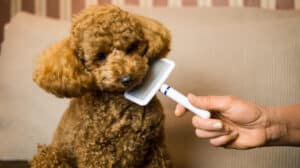American pit bull terriers have quite the reputation. Some people think of them as aggressive due to the bad press they receive, while others know them as lovable snuggle bugs. We talk about pit bull temperament a lot, but something else you might wonder is: do pit bulls shed?
Pit bulls shed moderately throughout the year, with no heavier shedding season. They’re single-coated with short hair, making their fur easy to maintain. Still, without a strict grooming and cleaning routine, you’re bound to find piles of fur around the house!
In this article, we’ll discuss how much pit bulls shed, how to lessen the amount of shed, and more.
Pit Bull Coat Characteristics
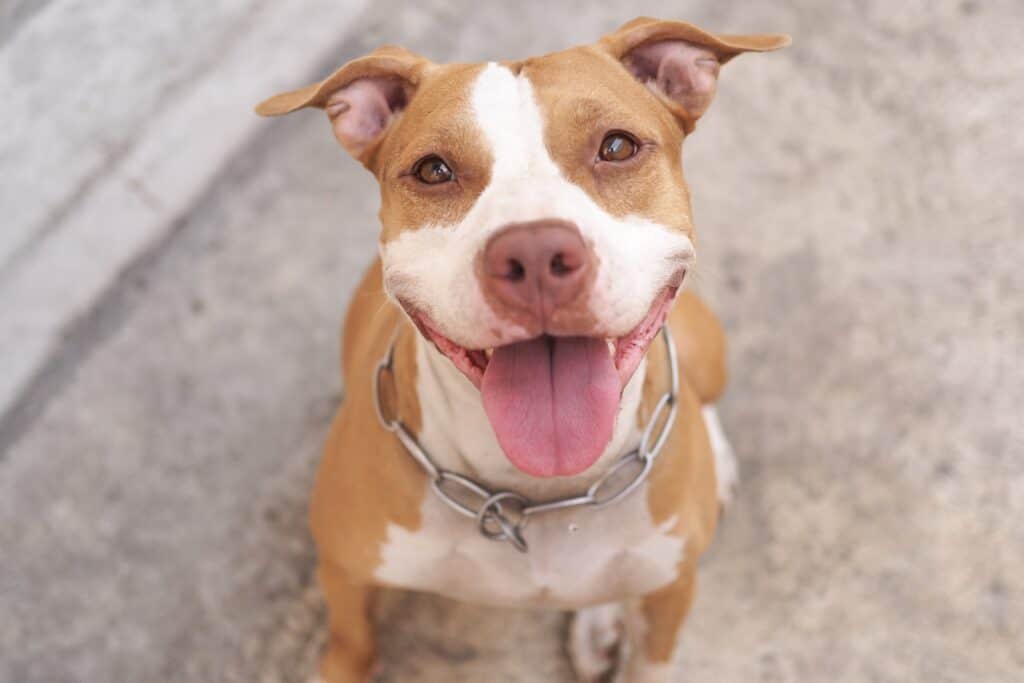
Pitbulls can be fierce and protective, but also loving and silly.
©Natthapot Chantaraviboon/Shutterstock.com
A quick note: The chart below is specific to the American pit bull terrier. While other dogs are wrongly called pit bulls, and some people group all bully breeds together under this label, I won’t do that here.
This is because the umbrella term hurts American pit bull terriers and gives them a worse reputation than deserved — for instance when a dog bites and is labeled as a “pit bull” by their victim and the media without knowing the dog’s actual breed. It’s also harmful to other bully breeds, who can face trouble getting adopted and even euthanasia in shelters simply for being labeled as a pit bull.
Without further ado, let’s dive into the American pit bull terrier’s coat characteristics!
| Coat Length | Short |
| Shedding Frequency | Moderate |
| Grooming Needs | Brush coat once weekly |
| Fur or Hair? | Fur |
| Hypoallergenic? | No |
When is Pit Bull Shedding Season?
Pit bulls don’t have a shedding season because they are single-coated dogs. Unlike double-coated breeds, they don’t blow out their undercoat each spring and autumn.
However, pit bulls still shed year-round — it’s just more consistent than double-coated breeds. Many pit bull owners wonder how such a short, thin coat can shed so heavily!
Are American Pit Bull Terriers Hypoallergenic?
There’s some debate in the dog world over whether hypoallergenic dogs are only a marketing ploy, or if they truly do produce fewer allergens. Regardless, American pit bull Terriers are not hypoallergenic.
They are not a “non-shedding” breed but instead shed moderately throughout the year. This, in theory, will produce more allergens than a breed that sheds less frequently.
If you have a dog allergy, always spend time around the specific dog you’d like to adopt first. Some people’s allergies seem to vary even within the same breed, so it’s important to know how you’ll react before committing to a new pupper!
How to Stop a Pit Bull from Shedding
Unfortunately, you cannot stop a pit bull from shedding — but you can lessen the amount that they shed. Here’s how:
- Brush their coat at least once a week. Brushing more often will mean less fur falling off of your dog and onto everything you own! There’s no such thing as too much brushing so long as your Pittie enjoys it.
- Bathe them with a deshedding shampoo.
- Schedule an appointment with a dog groomer. They can remove fur from your pup effectively and can also provide tips for keeping up with it at home! In my opinion, it’s worth going at least once as a learning experience.

The
American pit bull terrier
is active, playful, and loyal.
©dezy/Shutterstock.com
In addition, here are some tips for keeping up with pit bull hair around the house:
- Purchase vacuum attachments. I like pet attachments with bristles to brush out fur from carpet and furniture, and crevice tools with slanted ends to reach the corners between carpet and wall.
- Use a carpet rake for stuck fur. Our pups’ fur can sometimes wind together with the carpet threads, making it impossible to vacuum up. A carpet rake will release this fur and do wonders for the cleanliness of your home.
- Reusable lint rollers are a true gift! They’re better for the planet and your wallet. I like to keep at least one at home and one in the car at all times.
- Use a handheld vacuum or carpet rake on stairs. This will save you the pain of carrying around a heavy upright vacuum!
- Brush your pit bull outdoors. You’ll likely get out a lot of fur, and this way it won’t be sitting on your living room floor. If your pup isn’t on any topical parasite preventatives, you can even leave the fur outside, and birds will carry it away for nest-making.
How to Groom a Pit Bull
Grooming a pit bull is almost as easy as it gets! Still, there are multiple steps to grooming any dog. They include:
- Brushing the coat to lessen shed and distribute your dog’s natural oils
- Bathing as needed to keep the coat clean and looking its best
- Trimming the nails to prevent painful breakage or curling into paw pads
- Cleaning the ears to keep them healthy and free of debris
- Brushing the teeth to help prevent dental disease
We’ll dive further into these tasks below, including how often they should be completed and how to groom your pit bull from start to finish.
Brush Your Pit Bull’s Coat Weekly
If you’re not too concerned with shed fur, you can probably get away with brushing your pit bull less than recommended. However, it should still be done routinely. Brushing your dog’s coat helps to distribute their natural oils, which promotes better coat and skin health.
Of course, the more you brush your dog, the more you’ll catch shed fur. Remember, there’s no topcoat to hold a pit bull’s fur on their body, so it’ll constantly fall off wherever they’re at.
This can become messy quickly, and brushing them at least once a week can fix that. It should also take very little time since your Pittie should only need their coat gone over a handful of times before they’re good to go!
During brushing, I always recommend looking over your pup’s body. Feel for any lumps and look for any swelling, redness, pests, or dandruff. This can help you catch everything from fleas to dry skin to cancer, and no matter the severity, it’s always better to catch an illness early!
Bathe Them As-Needed
Your pit bull will likely stay relatively clean and might need a bath only a few times a year. Of course, some pups are more adventurous than others — if yours likes to roll in mud or rabbit poop, they’ll need to be washed more often.
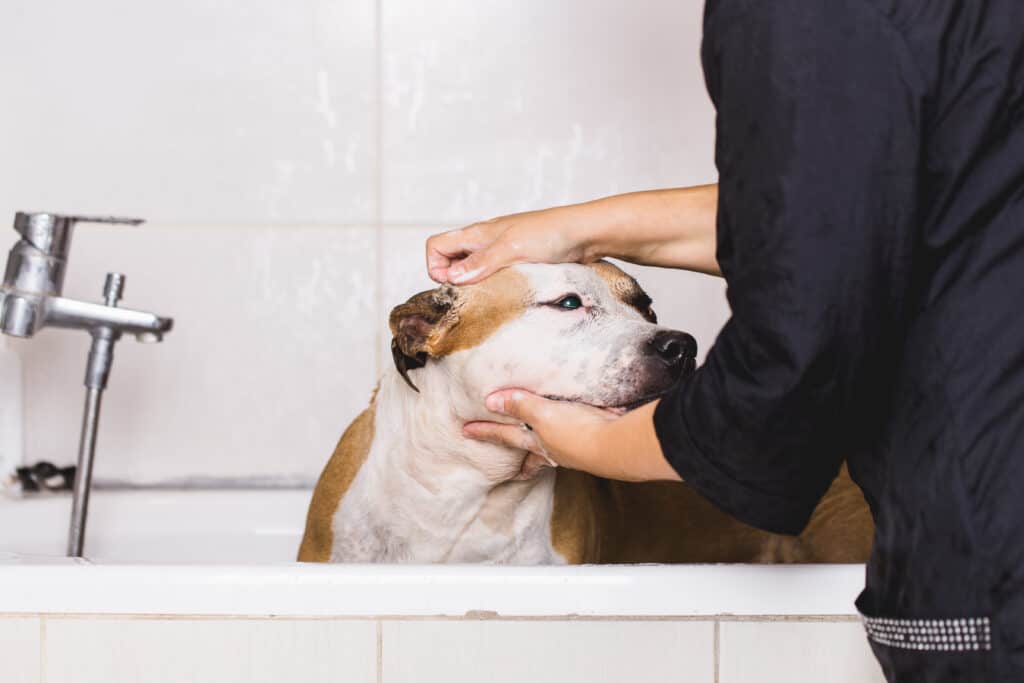
Bathing your dog will not only help with any bad smells, but it will keep your dog healthy and help you watch for any potential injuries or infections.
©iStock.com/DuxX
Here’s how to bathe your pit bull:
- Buy a dog shampoo. I personally prefer oatmeal shampoos, but anything made for dogs should do the trick. Human shampoos can cause skin irritation or dryness, so avoid those.
- Wet your dog’s body completely. Fill up the tub with a few inches of water and use a cup to pour it over your pit bull, or use a hose or shower head instead. Make sure you get the temperature right first!
- Place a dollop of shampoo on your hands and lather it into your pit bull’s fur. Be sure to get hard-to-reach places such as their feet, armpits, and beneath their collar. I like shampooing my dog’s collar as well since it usually stinks, too!
- Thoroughly wash away all of the shampoo. I rub my hand back and forth across the fur to ensure I haven’t missed any soap suds.
- Use dog conditioner or coconut oil to moisturize your dog if desired. This is optional but can help prevent dry skin and coat.
Trim Their Nails Monthly
Trimming your pup’s nails once a month will stop them from growing painfully long, which can make walking difficult or even cause the nails to curl into the paw pads. Long nails can also snag on objects and break unevenly, causing pain.
Some pit bulls might need their nails trimmed more often, but monthly is a good starting point. You can always trim them more if you notice them becoming long or sharp. Especially if your dog is a jumper (or loves to roughly hand you their paw when told to “shake!”) sharp nails can be a literal pain for us humans!
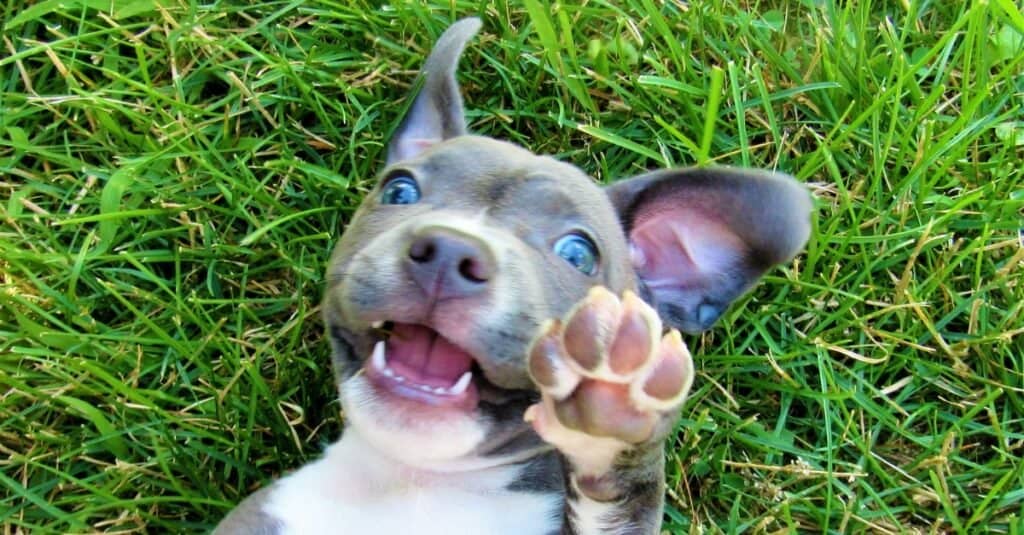
Pitt bulls may have light or dark colored nails., or even a combination of both.
©iStock.com/AimesElement
Here’s how to trim your pit bull’s nails successfully:
- Start with training. Desensitizing your pit bull to having their paws handled and to the nail trimmers themselves will go a long way! Begin by handling their paws while petting or cuddling them, and give them treats and praise for good behavior. Allow them to sniff the nail trimmers and hear the sound they make when clamping shut, and be sure to reward them for all positive interactions!
- Locate the quick. This is simple in light-colored nails — the quick looks like a pink spot near the base of each paw. In darker nails, however, it can be impossible to see. Knowing where the quick is located is important because it will bleed and hurt if cut into. Each dog’s nails are different, but at least having a general idea will reduce the chances of an accident.
- Cut only the tip of each claw. This will get you and your dog used to the process and lessen the possibility of cutting into the quick. As your confidence grows, you can slowly trim them shorter.
- Consider a nail Dremel or filing board. Both of these products only take small amounts of nail at a time, lessening the possibility of cutting into the quick. Dogs can be taught to scratch at a filing board themselves with some training and treats!
- Use cornstarch or flour to stop bleeds. If you cut into the quick, these should both stop the bleeding within minutes. If your dog continues to bleed for longer than this, seek veterinary attention as the injury could be serious.
Clean Your pit bulls Ears Once a Month
Cleaning your pit bull’s ears can help prevent ear infections and keep the ears free of debris. It can also decrease ear odor. It’s also very simple and feels great to most dogs! Here’s how to clean your pit bull’s ears:
- Flip the ear “inside-out” on top of your Pittie’s head. This way, you can see inside to know whether the ears are even dirty! Also look for redness, swelling, abnormal discharge, or strange odors — these can indicate ear problems such as infection or mites.
- Wet a Q-tip, cotton pad, or cotton ball with dog ear cleaner. You can also use a paper towel or a small amount of baby oil.
- Gently wipe away debris from the outer ear. This is the underside of the ear that’s most visible.
- Never stick anything inside your dog’s ear canal. This can push wax deeper inside or even rupture their eardrum. Just like Q-tips are bad to stick up our own ears, they can also hurt our dogs!
- If you notice excess wax in the inner ear, see a vet for a professional cleaning. They can get it out and also examine your dog for signs of ear infection, which can cause wax buildup.
Brush Their Teeth at Least Once Weekly
Like humans, dogs’ teeth build up plaque and tartar when not brushed. They’re more prone to cavities, tooth decay, and dental disease. Dogs should also have a dental cleaning once yearly at the veterinarian to keep up with those pearly whites!
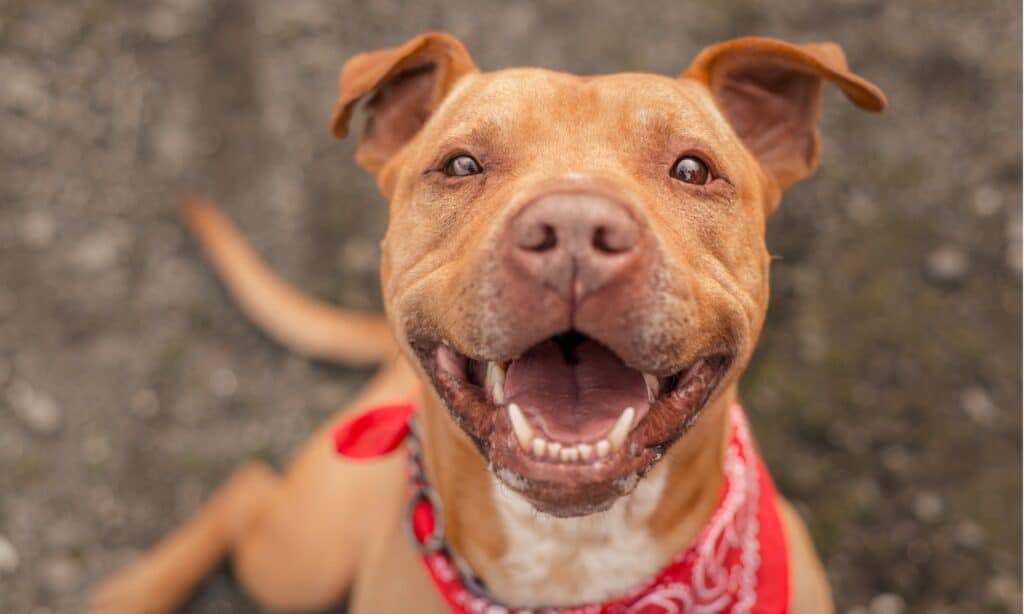
With patience and persistence, you can train your pit bull with a consistent dental cleaning routine.
©iStock.com/Photography by Adri
If you don’t know how to brush your pit bull’s teeth, here’s how:
- Purchase dog toothpaste and a toothbrush. The toothpaste must be made for dogs, not humans! You might also want to try various toothbrushes to see what works best for you — there are many styles including those that go on your finger, longer toothbrushes with bristles that wrap around the tooth, and even electric toothbrushes!
- To reiterate: never use human toothpaste on your dog! It isn’t meant to be swallowed and can poison them.
- Train your pit bull to accept handling and desensitize them to the toothbrush. This is what will take the most time — they aren’t naturally inclined to have a brush scrubbing their teeth and gums! Though, most Pitties will love the taste of the toothpaste. Take things slow and give your dog treats every step of the way, from licking the toothpaste for the first time to allowing you to brush a few teeth.
- Brush your dog’s teeth gently. It doesn’t require too much pressure, just enough to brush away most of the plaque.
- It doesn’t need to be perfect! Even brushing a few teeth at a time is perfectly fine. It might be difficult to get every bit of kibble off your pup’s teeth every day, but over time they’ll still benefit from any amount of cleaning.
Another less effective method is to feed your pit bull dental chews. This will help their teeth to stay clean, though it won’t do as good a job as you can with a toothbrush. If your dog won’t let you handle their mouth, dental chews can be a good compromise. You can also use them as a temporary fix until you’ve trained your dog to accept tooth brushing.
Up Next:
- The Best Chew Toys for Pit Bulls in 2022
- The 8 Best Dog Foods for Pit Bulls
- Pit Bull Lifespan: How Long do Pit Bulls Live?
The photo featured at the top of this post is © Susan Schmitz/Shutterstock.com
Ready to discover the top 10 cutest dog breeds in the entire world?
How about the fastest dogs, the largest dogs and those that are -- quite frankly -- just the kindest dogs on the planet? Each day, AZ Animals sends out lists just like this to our thousands of email subscribers. And the best part? It's FREE. Join today by entering your email below.
Sources
- The Atlantic, Available here: https://www.theatlantic.com/health/archive/2022/09/hypoallergenic-dog-allergies/671439/
- VCA Animal Hospitals, Available here: https://vcahospitals.com/know-your-pet/ear-infections-in-dogs-otitis-externa
- VCA Animal Hospitals, Available here: https://vcahospitals.com/know-your-pet/dental-disease-in-dogs
- American Kennel Club, Available here: https://www.akc.org/expert-advice/health/how-to-get-rid-of-fleas/
Thank you for reading! Have some feedback for us? Contact the AZ Animals editorial team.




